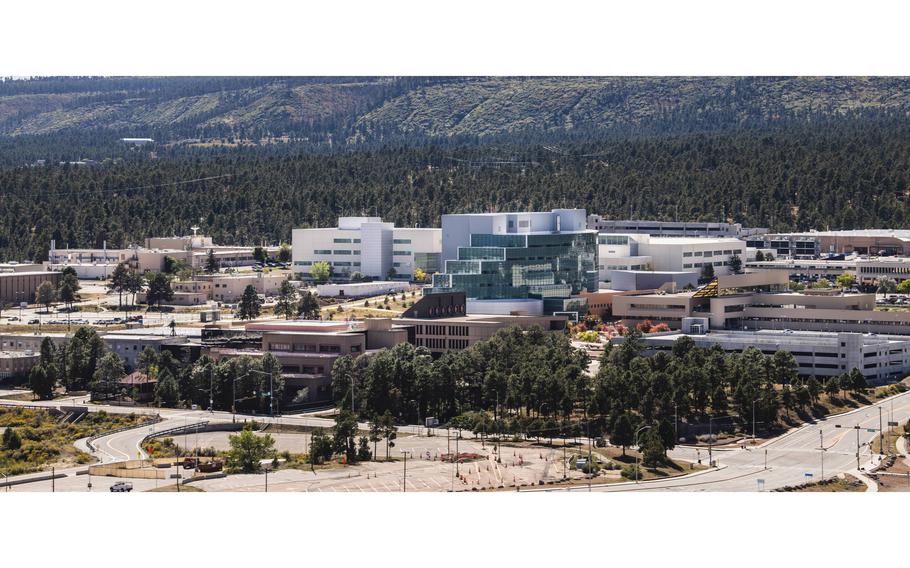
Los Alamos National Laboratory expects to see its budget swell to more than $5 billion in the coming fiscal year, far surpassing its previous funding levels. (Kevin Sutton/Los Alamos National Laboratory)
(Tribune News Service) — Los Alamos National Laboratory expects to see its budget swell to more than $5 billion in the coming fiscal year, far surpassing its previous funding levels.
The news comes just days after Congress approved the lab’s budget for the current fiscal year. Figures for that amount aren’t yet available because Congress has been funding agencies for months on stopgap measures known as continuing resolutions.
Congress authorized the U.S. Energy Department budget — which covers national laboratories — after election-year wrangling in the Republican-controlled House led to a tardy passage of funding for the current fiscal year.
The upcoming budget for the lab would include a $260 million increase President Joe Biden is requesting.
Early budget documents don’t make clear how much the lab would receive for its efforts to produce 30 nuclear warhead cores, or pits, by 2030, but it could be substantially more than this year’s $1.76 billion.
Meanwhile, proposed funding for the lab’s legacy waste cleanup would dip to $273 million from this year’s $286 million.
In all, the National Nuclear Security Administration, which oversees the country’s arsenal, would get a record $19.8 billion for its nuclear weapons programs, about $700 million more than this year.
“President Biden’s FY 2025 budget reflects today’s real-world conditions and our need to deliver while transforming the nuclear security enterprise,” Jill Hruby, the nuclear agency’s administrator, said in a statement. “We appreciate the long-standing bipartisan and bicameral support from Congress that allows us to design and deliver a modernized stockpile.”
The lab’s budget is already double what it was in 2019, and the pit operations and modernization funding is five times the amount budgeted four years ago.
Anti-nuclear activists have criticized what they call the ballooning weapons budgets, saying the federal government is using taxpayers’ money to feed an arms race. They contend the latest spending boosts are based on the same longtime fears of aggressive foes.
“The budgets are very bloated,” said Greg Mello, executive director of Los Alamos Study Group. “In the present threat environment, the labs know they can propose [budget increases] successfully.”
Hruby, along with Pentagon leaders and some politicians, say new plutonium pits are needed to modernize the arsenal so it will deter Russia, China, North Korea and rogue states from acting rashly with their weapons. They also will equip two new warheads being developed.
One warhead, the W87-1, will be key in replacing the outdated Minuteman class of missile with a next-generation intercontinental ballistic missile called the Sentinel. The other warhead, the W93 designed by the lab, will be mounted on missiles launched from submarines.
The Trump administration’s nuclear strategy called for the lab and Savannah River Site in South Carolina to produce no fewer than a combined 80 pits a year by 2030. Biden’s nuclear plan doesn’t specify a required number of pits to be made, but Hruby has stated her agency is sticking with the 80-pit goal. She has indicated it might not be reached until 2036.
The lab’s original timeline for fashioning 30 pits yearly was 2026. But production delays during the coronavirus pandemic, unforeseen challenges in obtaining the needed equipment and the endeavor being more complex than anticipated have pushed the target date to around 2030; the lab’s director hopes to achieve it sooner.
The nuclear agency is looking to spend about $456,000 on the new submarine warhead, about 89% more than two years ago. It also wants to bump spending on the Sentinel warhead to more than $1 million, a 61% increase from 2023.
Officials estimate the new warheads will require pits by the 2030s. The long-term budget projections in the president’s request call for spending a combined $4 billion a year on the Los Alamos lab’s and Savannah River’s pit production by 2029.
The escalated weapons spending is evidence the aim is to go beyond deterrence and bolster the military’s destructive nuclear warfighting power to outmatch its old rival Russia, said Jay Coghlan, executive director of Nuclear Watch New Mexico.
It’s why both countries have thousands of nuclear weapons rather than just a few hundred required for deterrence, he added.
“They have both had a hybrid of deterrence and nuclear warfighting capabilities that could end civilization overnight,” Coghlan said.
China expanding its nuclear arsenal has prompted military leaders to refer to that nation and Russia as near-peer nuclear adversaries, perhaps as justification to upgrade and eventually expand America’s arsenal, he said.
Meanwhile, he noted, the lab’s funding to clean up legacy waste from the Cold War has decreased, showing it’s a lower priority than beefing up the nuclear arsenal.
Stephanie Gallagher, a spokeswoman for the Energy Department’s Environmental Management Los Alamos Field Office, described the funding requests as ample for tackling the cleanup work.
That funding, Gallagher wrote in an email, will “continue to support mission-critical work for ongoing legacy waste operations.”
That includes planning for future below-ground waste remediation, soil and water investigations, regulatory compliance and shipping materials to the Waste Isolation Pilot Plant near Carlsbad, she wrote.
Mello said he believes the cleanup funding will increase by the time the final budget is passed. The Biden administration is probably holding down cleanup funding for now to help ratchet up the weapons budget, but officials will ask for more later, he predicted.
As for the swelling weapons budget, the lab is already running into funding surpluses, in part because it’s having trouble filling some of the jobs, Mello said.
“They have so much money they can’t spend it all,” he said.
(c)2024 The Santa Fe New Mexican (Santa Fe, N.M.)
Visit www.santafenewmexican.com
Distributed by Tribune Content Agency, LLC.